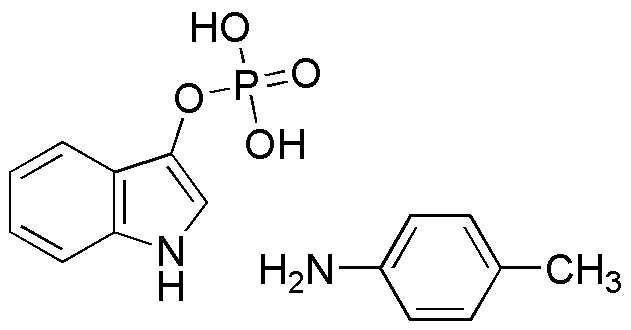3-Indoxyl phosphate, p-toluidine salt is widely utilized in research focused on:
- Biochemical Assays: This compound is often used in enzyme assays to measure the activity of phosphatases, providing a reliable method for studying enzyme kinetics.
- Histochemical Staining: It serves as a substrate for histochemical staining techniques, allowing researchers to visualize specific cellular components in tissue samples.
- Pharmaceutical Development: The compound plays a role in drug formulation, particularly in the development of pharmaceuticals targeting neurological disorders due to its interaction with certain receptors.
- Environmental Monitoring: It is applied in studies assessing the impact of pollutants on biological systems, helping researchers understand the effects of environmental toxins.
- Biotechnology Applications: The compound is utilized in various biotechnological processes, including the production of biosensors that detect specific biomolecules, enhancing diagnostic capabilities.
General Information
Properties
Safety and Regulations
Applications
3-Indoxyl phosphate, p-toluidine salt is widely utilized in research focused on:
- Biochemical Assays: This compound is often used in enzyme assays to measure the activity of phosphatases, providing a reliable method for studying enzyme kinetics.
- Histochemical Staining: It serves as a substrate for histochemical staining techniques, allowing researchers to visualize specific cellular components in tissue samples.
- Pharmaceutical Development: The compound plays a role in drug formulation, particularly in the development of pharmaceuticals targeting neurological disorders due to its interaction with certain receptors.
- Environmental Monitoring: It is applied in studies assessing the impact of pollutants on biological systems, helping researchers understand the effects of environmental toxins.
- Biotechnology Applications: The compound is utilized in various biotechnological processes, including the production of biosensors that detect specific biomolecules, enhancing diagnostic capabilities.
Documents
Safety Data Sheets (SDS)
The SDS provides comprehensive safety information on handling, storage, and disposal of the product.
Product Specification (PS)
The PS provides a comprehensive breakdown of the product’s properties, including chemical composition, physical state, purity, and storage requirements. It also details acceptable quality ranges and the product's intended applications.
Certificates of Analysis (COA)
Search for Certificates of Analysis (COA) by entering the products Lot Number. Lot and Batch Numbers can be found on a product’s label following the words ‘Lot’ or ‘Batch’.
*Catalog Number
*Lot Number
Certificates Of Origin (COO)
This COO confirms the country where the product was manufactured, and also details the materials and components used in it and whether it is derived from natural, synthetic, or other specific sources. This certificate may be required for customs, trade, and regulatory compliance.
*Catalog Number
*Lot Number
Safety Data Sheets (SDS)
The SDS provides comprehensive safety information on handling, storage, and disposal of the product.
DownloadProduct Specification (PS)
The PS provides a comprehensive breakdown of the product’s properties, including chemical composition, physical state, purity, and storage requirements. It also details acceptable quality ranges and the product's intended applications.
DownloadCertificates of Analysis (COA)
Search for Certificates of Analysis (COA) by entering the products Lot Number. Lot and Batch Numbers can be found on a product’s label following the words ‘Lot’ or ‘Batch’.
*Catalog Number
*Lot Number
Certificates Of Origin (COO)
This COO confirms the country where the product was manufactured, and also details the materials and components used in it and whether it is derived from natural, synthetic, or other specific sources. This certificate may be required for customs, trade, and regulatory compliance.


